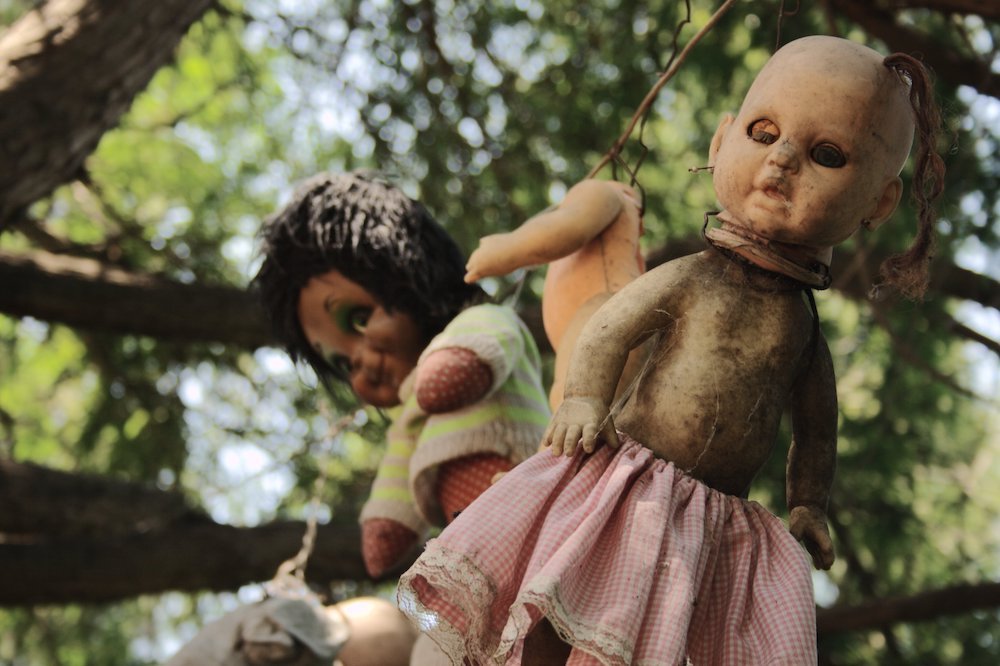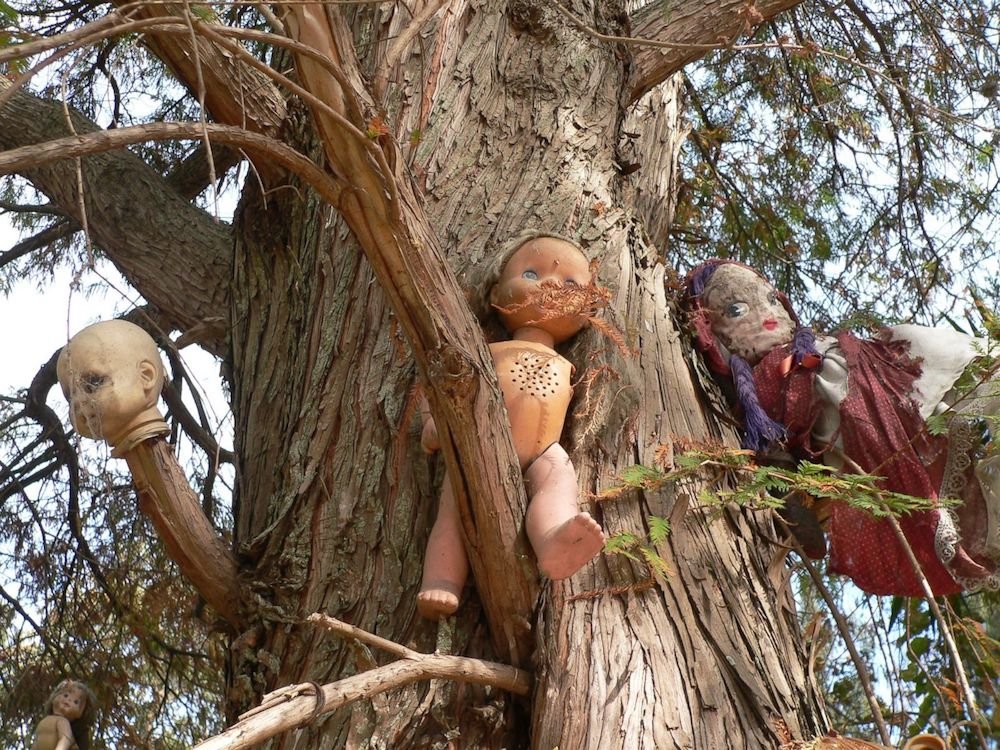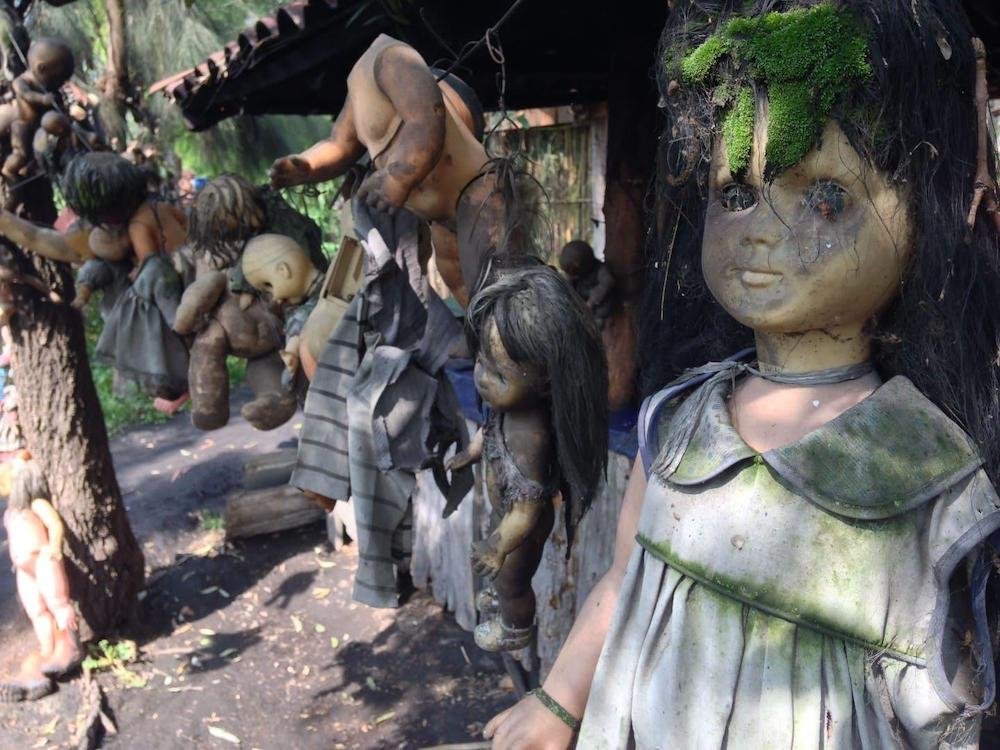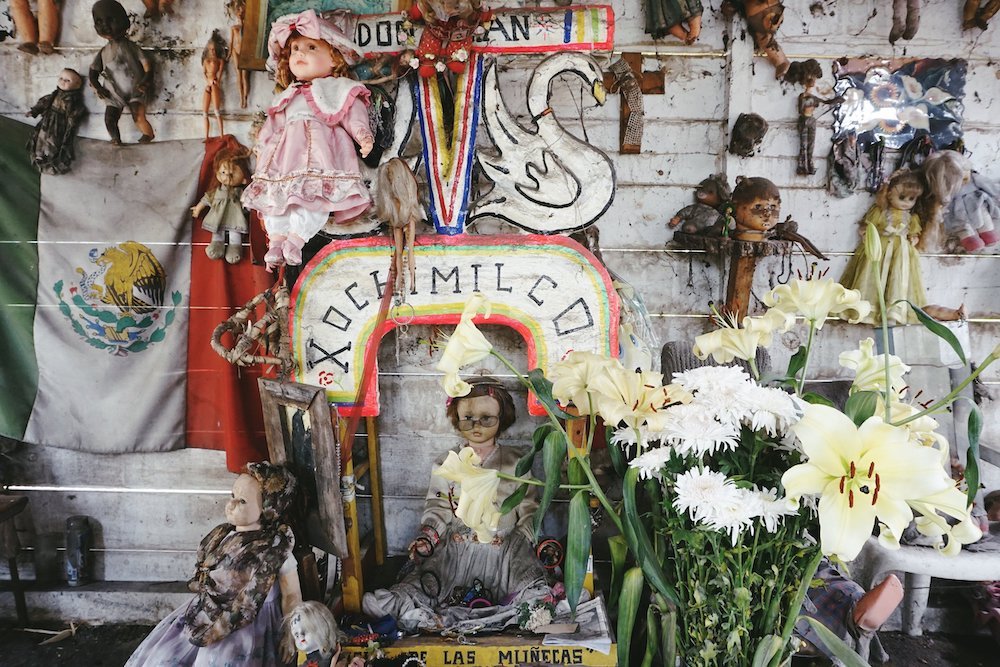
Nestled within the labyrinthine canals of Xochimilco, Mexico, lies an enigmatic and haunting destination known as the Island of the Dolls.
This peculiar sanctuary, adorned with thousands of weathered and decaying dolls, has captured the imaginations of travelers, adventurers, and storytellers alike.
In this article, we embark on a journey to unmask the secrets of Mexico’s creepiest island, delving into its rich history, eerie legends, and enduring mystique.
The Island of the Dolls, or Isla de las Muñecas in Spanish, is a small, uninhabited isle situated within the UNESCO World Heritage Site of Xochimilco.
Accessible only by boat, this secluded sanctuary has gained notoriety for its macabre collection of dolls, which dangle from trees, fences, and structures across the island’s landscape.
From a distance, the Island of the Dolls exudes an eerie ambiance, shrouded in mystery and suspense.
The sight of disheveled dolls, with their vacant stares and tattered attire, casts a haunting spell over visitors, evoking a sense of both fascination and dread.
Each doll bears witness to the island’s enigmatic past, silently narrating tales of forgotten lore and untold secrets.
Beyond its chilling facade, the Island of the Dolls holds a profound significance in Mexican folklore and cultural heritage.
Unraveling the mysteries concealed within its tangled vegetation and murky waters unveils a deeper understanding of the region’s history, beliefs, and traditions.
By peeling back the layers of myth and legend, we gain insight into the human psyche and our enduring fascination with the macabre.
History of the Island

The origins of the Island of the Dolls date back to the mid-20th century, in the heart of the Xochimilco canals near Mexico City.
Legend has it that the island was once the home of a reclusive hermit named Don Julián Santana Barrera.
Seeking solitude from the bustling city, Don Julián retreated to the tranquil waters of Xochimilco, where he discovered a desolate island engulfed by dense foliage and untamed wilderness.
Despite its secluded location, the Island of the Dolls became a focal point of fascination for travelers and locals alike.
Don Julián, driven by a haunting vision, began adorning the island with discarded dolls and toy remnants, which he salvaged from the surrounding canals.
Over the years, this makeshift shrine evolved into a sprawling collection of eerie artifacts, each imbued with its own spectral presence.
The Island of the Dolls holds deep cultural significance within the tapestry of Mexican folklore and tradition.
In pre-Columbian times, the Aztec civilization revered Xochimilco as a sacred site, believed to be a gateway to the realm of the gods.
Today, the island serves as a testament to the enduring legacy of indigenous belief systems, intertwined with elements of Catholicism and syncretic practices.
Legend of the Island

The Island of the Dolls is steeped in a rich tapestry of mythical tales and supernatural lore, passed down through generations of storytellers.
According to local legend, the origins of the island’s haunting presence can be traced back to a tragic incident involving a young girl who drowned in the waters surrounding Xochimilco.
Some believe that her restless spirit lingers among the dolls, seeking solace and redemption in the afterlife.
In Mexican folklore, dolls hold a symbolic significance, representing the boundary between the living and the dead.
It is said that the dolls adorning the island act as vessels for lost souls, serving as guardians of the spirit world and protectors of the natural realm.
Many visitors to the island pay homage to these spectral guardians, offering prayers and offerings in exchange for blessings and protection.
Among the myriad legends surrounding the Island of the Dolls, one story stands out as particularly chilling.
According to local accounts, Don Julián believed that the dolls possessed a life of their own, whispering secrets and foretelling omens to those who dared to listen.
Some claim to have witnessed the dolls moving of their own accord, their lifeless eyes following visitors with an unerring gaze.
The Island’s Haunting Appearance

As one approaches the Island of the Dolls, a sense of foreboding descends upon the tranquil waters of Xochimilco.
The island emerges from the mist like a ghostly apparition, its tangled vegetation and gnarled trees casting ominous shadows upon the landscape.
Silence reigns supreme, broken only by the rustle of leaves and the occasional creak of weathered dolls swaying in the breeze.
The island’s eerie ambiance is heightened by the presence of thousands of dolls, each bearing the scars of time and neglect.
Their porcelain faces, once vibrant and lifelike, now lay weathered and faded, their glassy eyes staring out into the void with a haunting intensity.
Limbs contorted and bodies disfigured, the dolls evoke a sense of unease and disquietude, their silent vigil casting a pall over the island’s desolate shores.
For visitors and locals alike, the Island of the Dolls exerts a magnetic pull, drawing them into its shadowy embrace with a mixture of fascination and trepidation.
Some come seeking thrills and chills, eager to confront the macabre and unearth its secrets.
Others approach with reverence and solemnity, paying homage to the spirits that dwell within the island’s haunted confines.
Julian Santana Barrera: The Caretaker

At the heart of the Island of the Dolls lies the enigmatic figure of Julian Santana Barrera, a reclusive caretaker whose solitary existence became intertwined with the island’s haunting legacy.
Born amidst the tranquil waters of Xochimilco, Julian was drawn to the island at a young age, captivated by its otherworldly allure and spectral presence.
For Julian Santana Barrera, the Island of the Dolls was more than a mere sanctuary; it was a refuge from the trials and tribulations of the outside world.
In the solitude of the island’s desolate shores, he found solace and companionship among the silent sentinels that populated its eerie landscape.
With each doll he salvaged and adorned, Julian sought to appease the restless spirits that dwelled within, forging a bond that transcended the boundaries of the mortal realm.
As the years passed, Julian Santana Barrera became synonymous with the island itself, his name whispered in hushed tones among those who dared to tread its haunted shores.
His tireless efforts to maintain the island’s macabre collection of dolls served as a testament to his unwavering devotion and dedication.
Yet, beyond his role as caretaker, Julian played a pivotal role in perpetuating the legend of the Island of the Dolls, transforming it from a mere curiosity into a realm of spectral intrigue and fascination.
Through his retelling of ancient tales and local folklore, Julian breathed life into the island’s haunted past, weaving a tapestry of myth and legend that continues to captivate the imagination of visitors and explorers to this day.
Though he has since passed into the annals of history, his legacy lives on, a testament to the enduring power of the human spirit and the mysteries that lie hidden within the shadows.
Origins of the Dolls

The arrival of the dolls on the Island of the Dolls remains shrouded in mystery, with numerous theories and speculations surrounding their origins.
According to local lore, the dolls were initially left as offerings to appease the spirit of a young girl who tragically drowned in the waters surrounding Xochimilco.
Over time, the island became a repository for discarded toys and artifacts, each imbued with its own spectral presence.
Different Theories and Speculations
While the exact origins of the dolls may never be known, various theories and speculations have emerged to explain their presence on the island.
Some believe that the dolls were placed as talismans to ward off evil spirits, while others suggest that they serve as guardians of the afterlife, guiding lost souls to their final resting place.
Still, others speculate that the dolls themselves are possessed by the restless spirits of the departed, their lifeless eyes bearing witness to untold tales of tragedy and despair.
Historical accounts and testimonies offer further insight into the enigmatic origins of the dolls and their significance within Mexican folklore.
Visitors to the island have reported encountering strange phenomena, including whispers in the wind and disembodied laughter echoing through the trees.
Some claim to have witnessed the dolls moving of their own accord, their porcelain faces contorted into eerie expressions of joy and sorrow.
Despite the passage of time, the mystery of the dolls endures, drawing travelers and explorers from far and wide in search of answers to the age-old question: Who left the dolls, and why?
Haunted or Hoaxed? Debunking Myths

The Island of the Dolls has long been associated with tales of supernatural phenomena and inexplicable occurrences.
Visitors to the island often report experiencing strange sensations and encounters, from disembodied whispers to apparitions that vanish into thin air.
While these claims may seem compelling, skeptics argue that they can be attributed to a variety of natural and psychological factors, rather than supernatural forces at work.
Psychologists and researchers have offered alternative explanations for the eerie ambiance of the Island of the Dolls, suggesting that the human mind is susceptible to suggestion and primed to perceive patterns where none exist.
The presence of dolls, with their uncanny resemblance to human form, may trigger feelings of unease and discomfort in some individuals, leading them to attribute benign stimuli to supernatural causes.
From a scientific perspective, the haunted reputation of the Island of the Dolls can be attributed to a combination of environmental factors and cultural conditioning.
The dense foliage and secluded location of the island create an atmosphere of isolation and disorientation, heightening the senses and fostering a sense of unease among visitors.
Moreover, the pervasive influence of folklore and urban legends serves to perpetuate the myth of the island’s supernatural origins, reinforcing belief in its haunted reputation.
Impact on Tourism and Popular Culture

The allure of the Island of the Dolls extends far beyond its eerie ambiance and haunting legends, drawing tourists and thrill-seekers from around the world to its desolate shores.
For many, the island represents a unique opportunity to confront their deepest fears and delve into the realm of the unknown.
Guided tours and boat rides offer visitors a glimpse into the island’s macabre past, inviting them to explore its haunted landscape and uncover the secrets that lie hidden within.
The Island of the Dolls has left an indelible mark on popular culture, inspiring a myriad of literary works, movies, and media portrayals that explore its enigmatic allure.
From ghost stories and horror novels to documentaries and television specials, the island’s haunting reputation has captivated the imagination of writers, filmmakers, and artists alike.
Its spectral presence has been immortalized in works of fiction and non-fiction, each offering a unique interpretation of the island’s dark and mysterious past.
The influx of tourists and visitors to the Island of the Dolls has had a significant impact on the local economy, providing a vital source of revenue for businesses and communities in the surrounding region.
Hotels, restaurants, and souvenir shops cater to the needs of travelers, offering a range of amenities and services designed to enhance their experience.
Moreover, the island’s cultural significance has been recognized by government agencies and conservation organizations, leading to initiatives aimed at preserving its natural beauty and historical heritage for future generations to enjoy.
Preservation Efforts and Conservation

Preserving the Island of the Dolls presents a myriad of challenges, ranging from environmental degradation to the ongoing threat of vandalism and deterioration.
The island’s remote location and limited accessibility make it difficult to monitor and protect against external threats, while its fragile ecosystem is vulnerable to the impacts of climate change and human activity.
Despite these obstacles, efforts are underway to safeguard the island’s natural beauty and cultural heritage for future generations to enjoy.
Numerous conservation initiatives and organizations have emerged in recent years to address the unique challenges facing the Island of the Dolls.
Local advocacy groups work tirelessly to raise awareness of the island’s significance and promote sustainable tourism practices that minimize its environmental footprint.
Government agencies and non-profit organizations collaborate on restoration projects and habitat preservation efforts, employing innovative strategies to mitigate the effects of erosion and habitat loss.
Despite the myriad challenges it faces, the future of the Island of the Dolls remains bright, buoyed by the collective efforts of dedicated individuals and organizations committed to its preservation.
As awareness of the island’s cultural and ecological importance continues to grow, so too does the momentum behind conservation efforts aimed at safeguarding its unique legacy.
By fostering a spirit of stewardship and community engagement, we can ensure that the Island of the Dolls remains a symbol of Mexico’s rich cultural heritage and natural beauty for generations to come.
Conclusion
The Island of the Dolls stands as a testament to the enduring power of myth and legend, its haunted shores shrouded in mystery and intrigue.
From its enigmatic origins to the spectral whispers that echo through its tangled foliage, the island captivates the imagination with tales of ghostly apparitions and otherworldly encounters.
Yet, amidst the darkness and uncertainty, the island holds a deeper truth waiting to be unearthed.
At its core, the Island of the Dolls represents more than a mere curiosity or macabre spectacle; it is a symbol of Mexico’s rich cultural heritage and natural beauty.
Through its eerie ambiance and haunting allure, the island serves as a reminder of the fragility of the human spirit and the enduring legacy of those who came before us.
Its significance transcends the boundaries of time and space, inviting us to explore the depths of our own imagination and embrace the mysteries that lie hidden within.

FAQ’s About the Island of the Dolls:
What’s the Story Behind the Island of the Dolls?
The Island of the Dolls, or Isla de las Muñecas, is located in the Xochimilco canals near Mexico City.
Legend has it that a man named Julian Santana Barrera discovered a girl drowned under mysterious circumstances and, as a tribute to her spirit, he began hanging dolls on the trees of the island.
He believed the dolls would appease her spirit. Over time, the island became covered with dolls, creating a haunting and eerie atmosphere.
How Many Dolls are on the Island of the Dolls?
There is no exact count of the number of dolls on the Island of the Dolls.
Estimates vary, but there are believed to be thousands of dolls scattered throughout the island, hanging from trees and buildings, and arranged in various states of disrepair.
How Much Does It Cost to Go to the Island of the Dolls?
The cost of visiting the Island of the Dolls depends on several factors, such as tour packages, transportation, and guided tours.
Prices can vary widely, ranging from around $20 to $50 USD per person for a boat tour of the Xochimilco canals, where the island is located.
Can You Still Visit Island of the Dolls?
Yes, the Island of the Dolls is still open to visitors.
Tourists and curious travelers can arrange boat tours of the Xochimilco canals, where the island is situated, to explore its eerie and haunting atmosphere.
How Long Does It Take to Get to the Island of the Dolls?
The time it takes to get to the Island of the Dolls depends on the starting point and mode of transportation.
From Mexico City, it typically takes around 1 to 2 hours by car or public transportation to reach the Xochimilco canals, where visitors can then embark on a boat tour to the island.
What Is the Nearest City to the Island of Dolls?
The nearest city to the Island of the Dolls is Mexico City, the capital of Mexico.
Mexico City is located approximately 17 miles (27 kilometers) northwest of the Xochimilco canals, where the island is situated.





